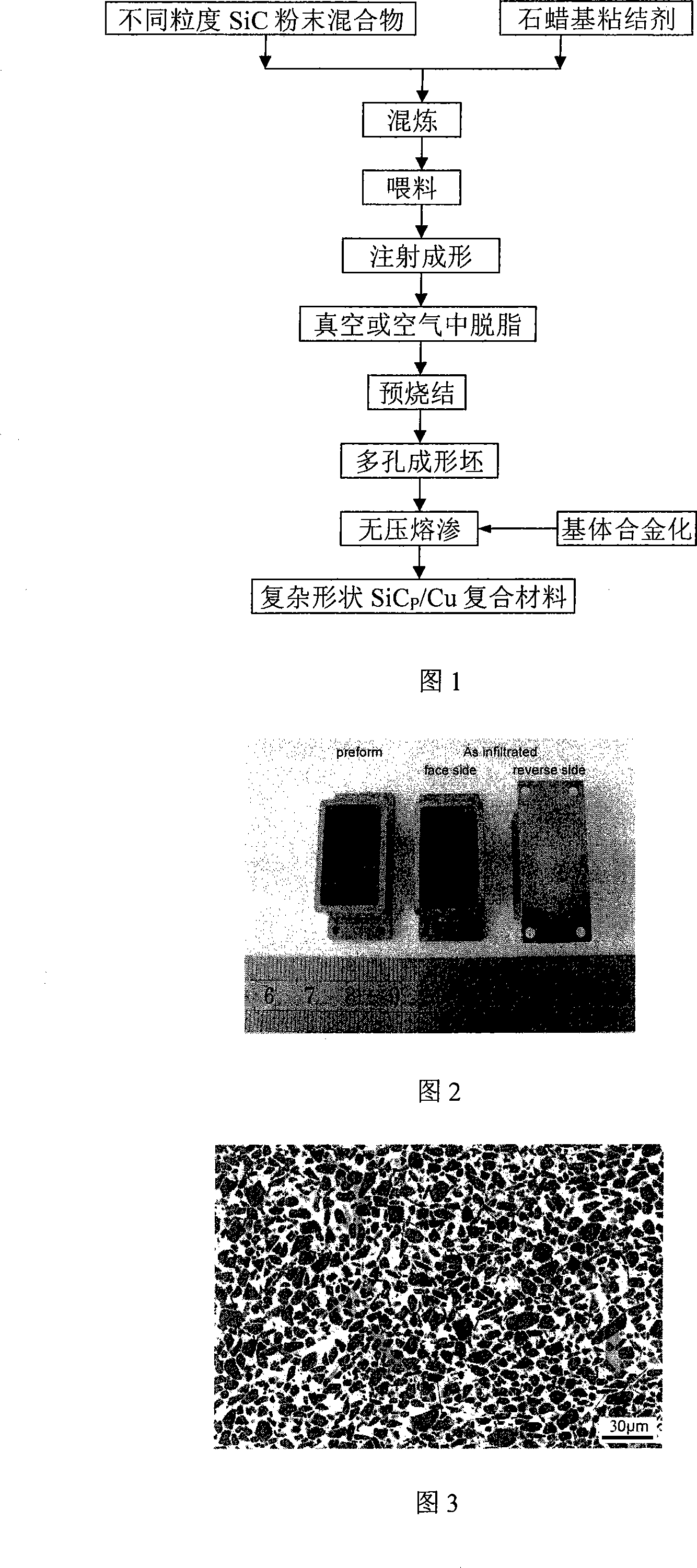Method for preparing high volume-fraction carborundum granule-reinforced copper-based composite material
A technology of copper-based composite materials and silicon carbide particles, which is applied in the field of metal-based composite materials, can solve the problems of non-wetting of SiC and Cu substrates, difficulty in achieving pressureless infiltration, and difficulty in distribution of ceramic particles, etc., to achieve porosity The effect of low density, high density and low cost
- Summary
- Abstract
- Description
- Claims
- Application Information
AI Technical Summary
Problems solved by technology
Method used
Image
Examples
Embodiment 1
[0016] Example 1: Preparation of SiC with a SiC volume fraction of 57% p / Cu composite material.
[0017] SiC powder with a particle size of 24 μm was mixed with a paraffin-based binder (65% paraffin, 15% high-density polyethylene, 15% polypropylene, and 5% stearic acid) on a twin-roll extruder to obtain SiC powder loading. The amount is 57% of the uniform feed; then injection molding is performed on a powder injection molding machine with an injection temperature of 140-160° C. and an injection pressure of 75-105 MPa to obtain a green body of a desired shape. The green body is solvent degreased in trichlorethylene, then slowly heated up to 450°C in a vacuum atmosphere to remove the binder, and then heated to 1000°C at a relatively fast speed for pre-sintering for 1 to 2 hours. Finally, pressureless impregnation with copper alloy (Cu-6Al) is carried out at 1400°C to 1450°C under vacuum atmosphere. Obtained SiC p The density of the / Cu composite is 97.8%, the content of the ...
Embodiment 2
[0018] Example 2: Preparation of SiC with a SiC volume fraction of 61% p / Cu composite material.
[0019] Using SiC powder with a particle size of 63 μm and a paraffin-based binder (65% paraffin, 20% high-density polyethylene, 10% polypropylene, and 5% stearic acid) with SiC powder as a loading of 61% in twin-roll extrusion After uniform mixing on a press, the feed material is injected on a powder injection molding machine at an injection temperature of 150-175° C. and an injection pressure of 75-125 MPa to obtain a green body. The green body should be solvent-degreased in trichlorethylene first, then slowly heated up to 450°C in a vacuum atmosphere to remove the binder, and then heated to 800°C at a relatively fast speed for pre-sintering for 1 to 2 hours. Finally, the copper alloy (Cu-5Al-2Fe-1Mn-2Ni) is infiltrated into the porous SiC preform by pressureless impregnation at 1410° C. to 1450° C. under vacuum atmosphere. Obtained SiC p The density of the / Cu composite is 9...
Embodiment 3
[0020] Example 3: Preparation of SiC with a SiC volume fraction of 64% p / Cu composite material.
[0021] SiC powders with particle sizes of 63 μm and 7 μm are used in a ratio of 3:1. First, the two powders were mixed evenly, and then the mixed powder was mixed with a paraffin-based binder (60% paraffin, 20% high-density polyethylene, 10% polypropylene and 10% stearic acid) with SiC powder as 64% loading. The amount is kneaded evenly on a twin-roll extruder, and then the green body of the required shape is produced on a powder injection molding machine with an injection temperature of 145-155 ° C and a pressure of 80-125 MPa. The green body is pre-sintered at 700°C in air after melting and degreasing. Then the copper alloy (Cu-4Ni) is infiltrated into the porous SiC preform by pressureless infiltration at 1420° C. to 1440° C. under vacuum atmosphere. Obtained SiC p The density of the / Cu composite material is 96.8%, the content of the reinforcing phase is 64% by volume, an...
PUM
| Property | Measurement | Unit |
|---|---|---|
| Thermal expansion coefficient | aaaaa | aaaaa |
| Thermal conductivity | aaaaa | aaaaa |
| Granularity | aaaaa | aaaaa |
Abstract
Description
Claims
Application Information
 Login to View More
Login to View More - R&D
- Intellectual Property
- Life Sciences
- Materials
- Tech Scout
- Unparalleled Data Quality
- Higher Quality Content
- 60% Fewer Hallucinations
Browse by: Latest US Patents, China's latest patents, Technical Efficacy Thesaurus, Application Domain, Technology Topic, Popular Technical Reports.
© 2025 PatSnap. All rights reserved.Legal|Privacy policy|Modern Slavery Act Transparency Statement|Sitemap|About US| Contact US: help@patsnap.com

